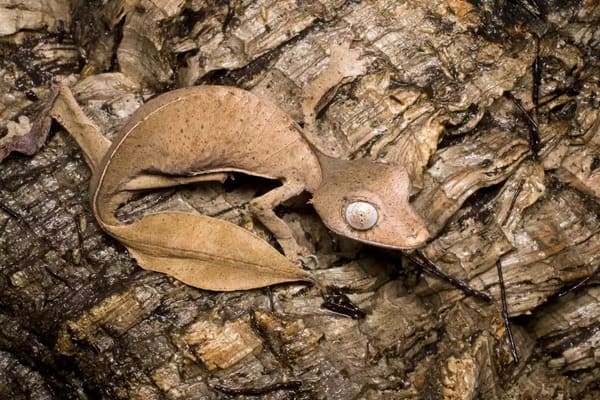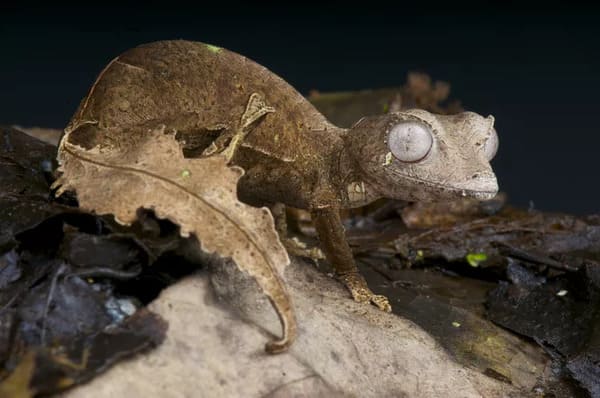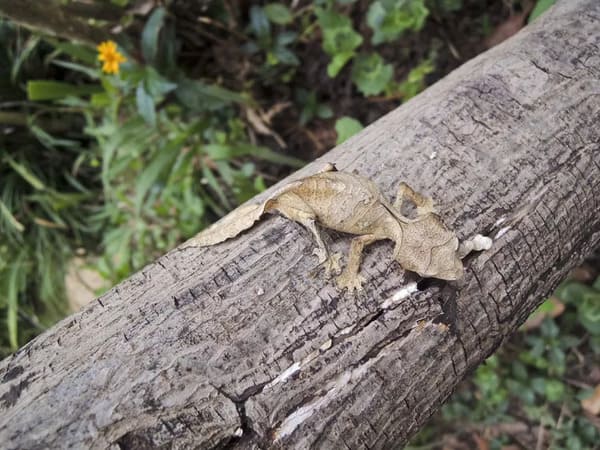The evil leaf-tailed gecko (Uroplatus phantasticus) is a gentle reptile that, despite its name, prefers to nap quietly in the forests of Madagascar. It has evolved an extreme method of camouflage: turning into a dead leaf.

Scientific name: Uroplatus phantasticus
Common name: Satan's leaf-tailed gecko
Basic Animal Group: Reptiles
Dimensions: 2.5–3.5 inches
Weight: 0.35–1 oz
Lifespan: 3-5 years
Diet: Carnivore
Habitat: Mountain rainforest of eastern Madagascar
Protection status: no worries
The devil's leaf-tailed gecko is one of 13 recognized species belonging to the genus Uroplatus, which were discovered on the island of Madagascar in the 17th century. The 13 species are divided into groups based in part on the vegetation they imitate. U. phantasticus belongs to the group called U. ebenaui, which consists of three members, including U. malama and U. ebenaui: all three members look like dead leaves.
All leaf-tailed geckos have long, flat bodies and triangular heads. Evil leaf-tailed geckos are mottled brown, grey, tan or orange, the same color as decaying leaves in their natural environment. The gecko's body curves like the edges of a leaf, and its skin has lines that mimic leaf veins. But the most eye-catching accessory of the leaf-tailed gecko's camouflage is undoubtedly its tail: of all the Ebenae gecko groups, the leaf-tailed gecko has the longest and broadest tail. The lizard's tail is not only shaped and colored like a leaf, but also has notches, frills, and blemishes that more closely resemble dead leaves that have been chewed by insects.
Like other members of the group, the Satanic leaf-tailed gecko is smaller than other Uroplatus groups, measuring between 2.5 and 3.5 inches in length including the tail.

This vicious leaf-tailed gecko is found only in the mountainous rainforests of the eastern two-thirds of Madagascar, a large island nation off the southeastern coast of Africa. It is found at the base of trees, masquerading as leaf litter, up to about 6 feet up the trunk. Known for its unique wildlife, Madagascar's forests are home to lemurs, burrowing and hissing cockroaches, as well as the world's only known evil leaf-tailed gecko.
The evil leaf-tailed gecko rests all day, but once the sun goes down, it's on the prowl in search of food. Its large, lidless eyes are built for spotting prey in the dark. Like other lizards, this gecko is thought to feed on anything it can capture and put in its mouth, from crickets to spiders. However, Satanic leaf-tailed geckos have been poorly studied in their native environment, so we can't be sure what else they eat.
The evil leaf-tailed gecko doesn't rely on passive camouflage to protect itself. It also behaves like a leaf when resting. When a gecko sleeps, its body lies flat on a tree trunk or branch, head down, leaves and tail up. If necessary, it twists its body to accentuate the leaf-like edges and help it blend in.
It has a limited ability to change color, and when its camouflage fails, it will flick its tail upwards, tilt its head back, open its mouth to reveal its bright orange-red interior, and sometimes even emit a loud distress signal.

In their native Madagascar, the start of the rainy season also marks the start of the gecko breeding season. When sexually mature, male Satanic leaf-tailed geckos have a bump at the base of their tail, while females do not. The female is oviparous, meaning she lays eggs and the young develop fully outside the body.
A gecko mother will lay a clutch of two to three spherical eggs in the leaf litter on the ground or in the dead leaves of plants. This allows the larvae to remain hidden when they emerge about 95 days later. She may have two or three litters a year. Little is known about this mysterious animal, but it is believed that the mother leaves her eggs behind for them to hatch and hatch on their own.
Although currently listed as a species of least concern by the International Union for the Conservation of Nature and Natural Resources, this unusual lizard may soon be in danger. Madagascar’s forests are degrading at an alarming rate. Exotic pet enthusiasts have also created high demand for collecting and exporting the species, which is currently illegal, but numbers are likely to continue to decline.
animal tags: gecko
We created this article in conjunction with AI technology, then made sure it was fact-checked and edited by a Animals Top editor.